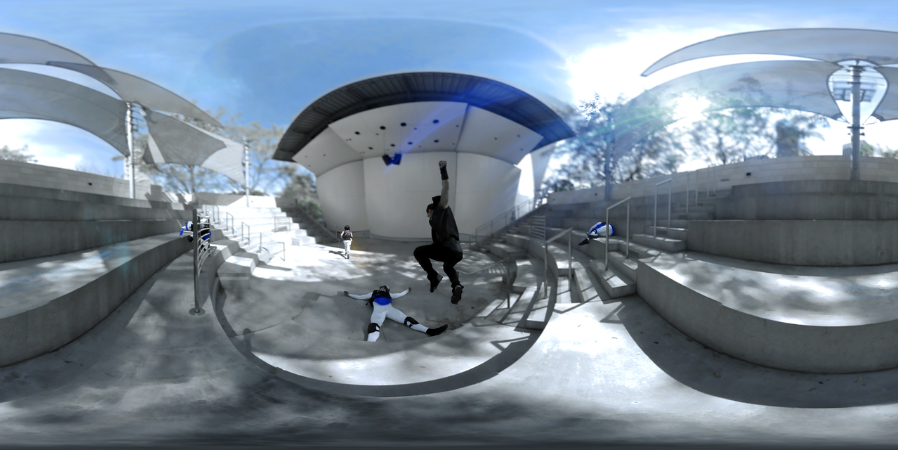In a pair of firsts, YouTuber MatPat has launched MatPat’s Game Lab, which drops viewers into a live-action parkour adventure inspired by Electronic Arts’ DICE-developed Mirror’s Edge Catalyst. Specular Theory worked in tandem with MatPat to create 360-degree gameplay experiences set inside Mirror’s Edge Catalyst. While Game Lab is available only to YouTube Red subscribers, the 360-degree videos are available for free.
Specular Theory has been immersed in 360-degree storytelling, having worked on projects including the Sundance hit Perspective Chapter 2: The Misdemeanor, the Jeep VR Surf Experience, and Terminator Genisys: The YouTube Chronicles 360. Specular Theory CEO and Game Lab VR series director Morris May talks about entering the 360-degree video game world in this exclusive interview.
How did you get involved with this project?
MatPat had seen some of our previous work and reached out to us to push the boundaries from both a technical and storytelling perspective on the 360 component of the series. The various first-person perspective and moving camera approaches in our previous work really attracted him, and he wanted to collaborate to explore that kind of variety in storytelling.
How does your 360 content tie into the MatPat series?
Each of the episodes follows MatPat and friends as they are thrown into real life situations based on video games to see how they perform. Each 360 companion video follows the same title and gives viewers the opportunity to be dropped into the world of the same game that MatPat has in that episode. However, the 360 episodes utilize a variety of approaches—at times using a scripted, narrative approach—to drop viewers in the middle of the action within the world of the game, and other times allowing viewers to have a front row seat to MatPat and his friends taking on the zany real-world versions of the game titles. The 360 episodes will be available for free to all viewers, while the remainder of the 2D episodes will be available only to YouTube Red subscribers.
What is 360-degree video opening up for exploration of existing game worlds?
It is a mind-blowingly exponential advancement. Viewers can be inside of the game and have the chance to explore on their own in a full 360-degree environment. They can be completely immersed and interact with the world of the game on their own cell phone, which opens it up to a massive audience.
Can you explain how you worked with Electronic Arts and DICE on this project?
The series’ executive producer, Dan Levitt, handled the coordination with the game companies, but since MatPat has such a massive following in the gaming space, we were given a lot of creative freedom with bringing the world of these game titles to life in live-action. MatPat really wanted to use the 360 experiences to allow his viewers to get a piece of the action and get a chance to take on the unique real-life game experiences that he was tackling in the series. We used a limited amount of gameplay clips for some of the episodes, but primarily re-created the game environments in live-action.
How much gameplay did you capture and how did you translate that into these shorter form experiences?
We shot over four hours of VR content for the series with many shoots involving multiple cameras, including drones and custom rigged cameras. We delivered over 45 minutes of VR footage, which was 40 terabytes of data.
Creatively, what does 360 open up for you?
Three-sixty really allows viewers to explore the space and be fully immersed in a unique environment and guided along on a journey. It’s an entirely new medium that we are navigating as the technology is continuing to develop. The possibilities are endless and it’s a really exciting time in filmmaking and storytelling.
How much interaction does the viewer have?
This particular series does now allow for as much interaction, as it was designed to be viewable on YouTube 360 and in Cardboard to allow as many viewers as possible. However, we designed the experiences to have a game-like feel with action constantly going on all around the viewer, encouraging them to explore the full space and really feel that they’re a part of the game and the adventure.
What do you see the launch of PlayStation VR and Google Daydream this fall adding to the VR ecosystem?
It is going to be game-changing and lead to a rapid mass adoption of the VR medium. All new Android phones will be equipped with Google Daydream and will allow people to get amazing VR experiences right on their phones. With PlayStation, there are already so many households with consoles, so adding a headset will be a natural upgrade for them. We are extremely excited to see how much the audience for VR content will open up with both of these launches.
What opportunities do you see for brands and sponsors of this type of 360 gameplay experiences?
VR is a dream come true for brands. It gives them the opportunity to reach a fully captivated audience that is simply not possible with any other medium. In VR, audiences can’t be on their phone or have another conversation as a distraction. So for brands, VR really allows them to create fully immersive experiences. And from a brand storytelling perspective, the participatory factor really leaves a singular lasting impression and creates memories on a much more personal level.

